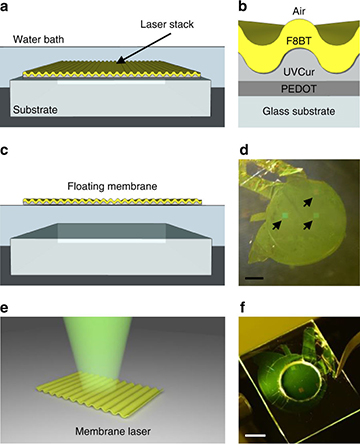
In the St. Andrews group’s approach, an organic laser stack, consisting of a semiconducting organic polymer (yellow) and a UV-curable resonator layer, is attached to a glass substrate with a water-soluble layer (a and b) and peels off when immersed in water (c and d; scale bar = 3 mm). The material lases green (e) when stimulated by pulsed blue light (not shown), and can be suspended in air or transferred onto another substrate (f; scale bar = 5 mm). [Image: Karl et al., Nat. Commun. 9, 1525 (2018); CC-BY 4.0]
Researchers from the University of St. Andrews, U.K., have demonstrated ultrathin, ultra-lightweight, flexible organic lasers that can operate as free-standing membranes or can be transferred onto a substrate, such as a contact lens (Nat. Commun., doi:10.1038/s41467-018-03874-w). While not exactly enabling Superman’s laser vision, these flexible organic optoelectronic devices, according to the research team, could be harnessed for new applications in security, biophotonics and medicine.
A solution-based solution
Optically pumped organic solid-state lasers are comparatively inexpensive to produce and broadly tunable in the visible range. But because they have required a solid support substrate, organic lasers have remained relatively bulky and unyielding, which has limited their potential applications.
To get around those issues, the St. Andrews team opted for a different kind of organic laser—a setup that comprised only a distributed-feedback (DFB) resonator and an organic semiconductor for gain. That opened up the prospect of much more flexible and much thinner laser than other flexible DFP designs, which have used macroscopically thick substrates or metal-oxide intermediate layers.
To make the thin membrane lasers at a reasonable cost, the team developed a completely solution-based process—a “water-based lift-off technique” that releases the final laser from the carrier glass substrate once fabrication is complete. Initially, the stack consists of the glass substrate, a 50-nm-thick water-soluble layer, a UV-curable imprint resist defining the DFB resonator, and a layer of an organic semiconducting polymer that acts as the gain material. When the stack is submerged in water, the hydrophobic membrane detaches from the stack, is readily picked up from the water surface, and either is left freestanding in air or is transferred onto another substrate.
Once it floats away from the glass, the laser is flexible, lightweight, and ultra-thin. Moreover, replacing the glass substrate (refractive index, n =1.52) with air (n = 1.7) improves the confinement of the lasing mode to the gain material and also reduces spontaneous emission losses. The result, according to the researchers, is 200-nm thick laser that can be optically pumped, at sufficiently low pumping and emission to make it potentially safe for human eyes.
Banknotes and bovine eyes
According to the researchers, the membrane lasers’ flexibility and transferability constitute two particularly important features for applications. After “lift-off,” the lasers can adhere to a wide variety of substrates—even currency for the sake of authenticity control. “By varying the materials and adjusting the grating structures of the laser,” explained Markus Carl, a Ph.D. student at St. Andrews, in a press release accompanying the work, “the emission can be designed to show a specific series of sharp lines on a flat background—the ones and zeros of a digital barcode.”
As a proof of concept, the team applied a series of membrane lasers to a £5 banknote and repeatedly bent the bill without delaminating or damaging it. Upon pulsed excitation of the bill, the researchers observed lasing at a 38.2 kW cm⁻2 threshold. Moreover, over the course of 200 days, the researchers tested the longevity of the lasers after being stuck to the banknote, and found that their optical properties did not change.
![]()
The team was able to drape the organic laser on a commercial contact lens, and attach it to a bovine eye to test out a low-power ocular laser. [Image: Karl et al., Nat. Commun. 9, 1525 (2018); CC-BY 4.0]
In another set of experiments, the team wanted to test whether the membrane lasers could function as a wearable security tag on contact lenses, to complement a biometric-authentication iris scan. The lasers’ ultrathin design allowed for their transfer to a standard contact lens and subsequent placement onto a bovine eye. Due to the high transparency and low thresholds of the lasers, a well-defined green laser beam emerged from the cow’s eye upon optical excitation with 5-ns pulses of 450-nm blue light, repeated at a 5-Hz rate—successfully demonstrating an ocular laser.
But could such lasers really be eye-safe? The researchers think so. The threshold pump fluence to achieve lasing in the bovine-eye experiments was 56.8 kW cm⁻2. While that sounds like a high number, the researchers point out that it’s nearly an order of magnitude below the American National Standards Institute’s 505.1 kW cm⁻2 maximum permissible corneal irradiance for light at a similar wavelength, pulse duration and repetition rate. That suggests, the researchers write, that “a membrane laser on a contact lens could thus—under appropriate pumping conditions—be safely operated while being worn in the eye.”
Future applications
In the future, the team notes that the effective gain spectrum of the device could be broadened by combining different organic polymers to exponentially increase the number of unique output spectra that can be generated. By further optimizing the DFB grating, the researchers also believe that they can make the membrane lasers work at lower lasing thresholds, and even using LED rather than pulsed-laser pumping. And the researchers believe that these membrane lasers could have a low production cost through the use of nanoprint and organic ink jet printing technology.
Malte Gather, the leader of the St. Andrews research team, argued that the work “represents a new milestone in laser development, and, in particular, points the way to how lasers can be used in inherently soft and ductile environments.”
